To conserve water while sipping tea, opt for water-efficient varieties like green and compressed teas. Use reusable tea bags or infusers to reduce waste, and try cold brewing to save energy. Measure precise water amounts and heat to ideal temperatures for each tea type to avoid excess. Repurpose used tea leaves in your garden or beauty routine. Invest in energy-saving kettles with temperature control features for efficient brewing. By adopting these eco-friendly practices, you'll not only reduce your environmental impact but also enhance your tea experience. Discover more ways to make your tea ritual sustainable and enjoyable.
Choosing Water-Efficient Tea Varieties

Several tea varieties require less water to steep, making them ideal choices for eco-conscious tea drinkers. Opt for teas that infuse quickly and don't need large amounts of water to release their flavors.
Green teas, particularly Japanese varieties like sencha and gyokuro, are excellent options. They typically require less water and shorter steeping times compared to black teas.
Oolong teas, especially those that are lightly oxidized, also make great water-efficient choices. You'll find that many high-quality oolongs can be steeped multiple times, allowing you to enjoy several cups from a single serving of leaves. This practice not only conserves water but also maximizes the value of your tea.
Consider trying compressed teas like pu-erh cakes or tea balls. These dense forms of tea can be brewed with less water while still producing rich, flavorful cups.
White teas are another eco-friendly option, as they're often delicate and don't require much water to extract their subtle flavors.
Reusable Tea Bags and Infusers
How can you reduce waste while enjoying your favorite tea? One of the most effective ways is to switch to reusable tea bags and infusers. These eco-friendly alternatives eliminate the need for disposable tea bags, which often contain plastic and contribute to landfill waste.
Reusable tea bags come in various materials, including organic cotton, hemp, and food-grade silicone. They're easy to clean and can be used hundreds of times before needing replacement. Simply fill the bag with your loose-leaf tea, steep, and rinse after use.
Tea infusers offer another sustainable option. Made from stainless steel, silicone, or bamboo, these durable tools come in various designs, from simple mesh balls to novelty shapes. They're perfect for single servings or small teapots and allow tea leaves to expand fully, enhancing flavor.
For larger quantities, consider a tea basket that fits inside your teapot. These larger infusers accommodate more leaves and are ideal for serving multiple cups.
Cold Brew Tea Methods
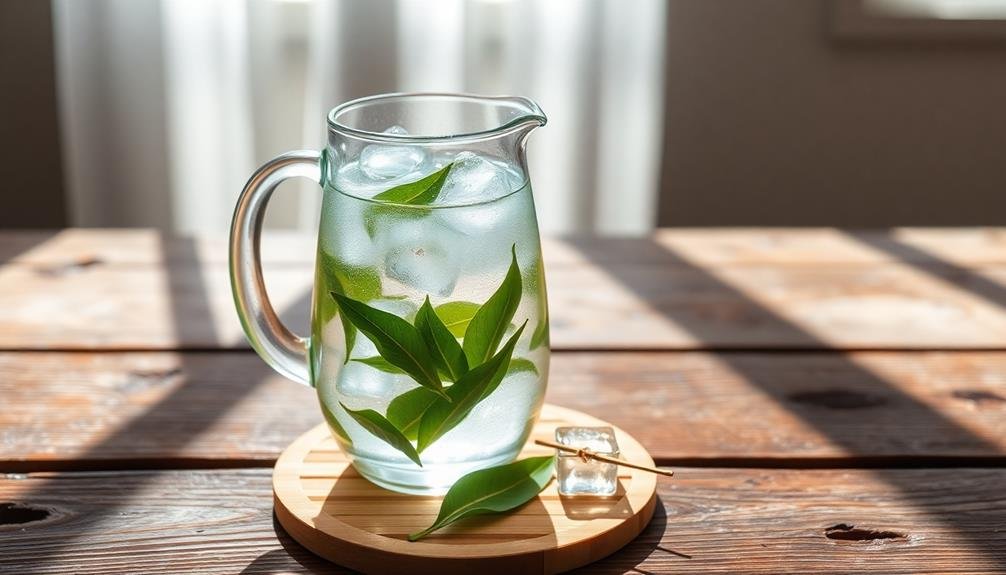
While reusable tea tools are great for hot brews, cold brew methods offer another eco-friendly approach to enjoying tea. You'll find that cold brewing not only conserves energy but also reduces water waste.
To start, simply place your tea leaves or bags in room temperature water and refrigerate for 6-12 hours. This method extracts flavors slowly, resulting in a smoother, less bitter taste.
You can use a variety of containers for cold brewing, from mason jars to pitchers. For loose leaf tea, try a cold brew bottle with a built-in infuser. These bottles allow you to easily remove the leaves after steeping, preventing over-extraction. If you're using tea bags, a standard glass jar works well.
Cold brew tea is versatile and can be enjoyed straight or diluted with water or ice. It's also an excellent base for iced tea cocktails or mocktails.
Optimal Water Temperature for Conservation
When it comes to eco-friendly tea steeping, getting the water temperature right can make a significant difference in energy conservation. You'll save energy and preserve the tea's flavor by using the ideal temperature for each type of tea. Here's a quick guide to help you:
| Tea Type | Temperature (°F) | Steeping Time |
|---|---|---|
| White | 160-170 | 1-3 minutes |
| Green | 170-180 | 2-3 minutes |
| Oolong | 180-190 | 2-5 minutes |
| Black | 200-212 | 3-5 minutes |
| Herbal | 212 | 5-7 minutes |
To conserve energy, heat only the amount of water you need. Use an electric kettle with temperature control for precise heating. If you don't have one, bring water to a boil and let it cool to the desired temperature. You can use a thermometer or estimate by watching the water's surface. Small bubbles indicate around 160-170°F, while large bubbles suggest 180-190°F. For black and herbal teas, use water just off the boil. By following these guidelines, you'll not only save energy but also enjoy perfectly brewed tea every time.
Measuring Precise Water Amounts
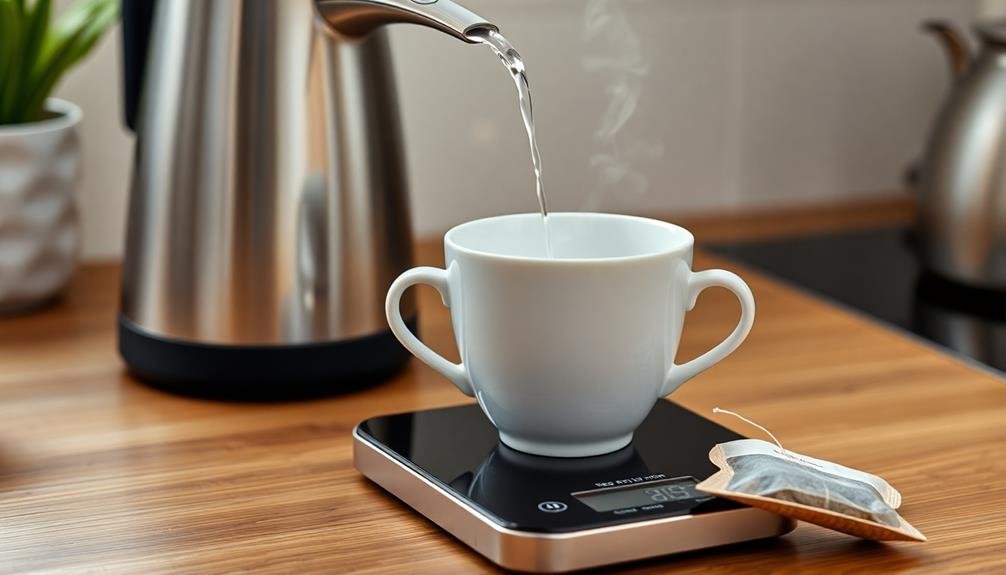
Measuring precise water amounts goes hand in hand with using ideal water temperatures for eco-friendly tea steeping. You'll need to be mindful of how much water you're using to avoid waste and guarantee the perfect brew.
Start by investing in a kitchen scale or a measuring cup with clear markings. For a single cup of tea, you'll typically need about 200-250ml of water, but this can vary depending on your cup size and personal preference.
When filling your kettle, measure only the amount you need for the number of cups you're making. This practice not only conserves water but also saves energy by heating less.
If you're using a teapot, pre-measure the water into your cups first, then pour it into the kettle. This method guarantees you're boiling exactly what you need.
For loose leaf tea, use a ratio of about 2-3 grams of tea per 200ml of water. A small kitchen scale can help you measure tea leaves accurately.
Repurposing Used Tea Leaves
Don't toss those used tea leaves!
You'll find numerous eco-friendly ways to repurpose them, from enriching your garden soil to creating natural cleaning solutions for your home.
You can even incorporate spent tea leaves into DIY beauty treatments, making the most of their beneficial properties long after your cup of tea is finished.
Gardening and Composting Benefits
Tea leaves don't have to end their journey in your cup. These nutrient-rich remnants can benefit your garden and compost pile in several ways. When added to soil, used tea leaves improve drainage and aeration while slowly releasing nutrients. They're particularly beneficial for acid-loving plants like rhododendrons, azaleas, and blueberries.
You can sprinkle damp tea leaves directly around plants as a mulch or mix them into potting soil. They'll help retain moisture and suppress weed growth.
For composting, tea leaves are an excellent "green" material, rich in nitrogen. They break down quickly, accelerating the composting process and enriching your final product.
Don't forget about tea bags. If they're made of natural fibers like cotton or hemp, you can compost them whole. For plastic-based bags, cut them open and compost only the leaves.
You can also use whole tea bags to line plant pots, improving drainage and preventing soil loss.
Natural Cleaning Solutions
Beyond their garden benefits, used tea leaves can also be repurposed as natural cleaning solutions around your home. These versatile remnants can tackle various cleaning tasks, reducing your reliance on harsh chemicals.
For wood surfaces, brew a strong tea solution and use it to clean and polish furniture. The tannins in tea will help restore shine and remove grime.
You can also deodorize carpets and rugs by sprinkling dried tea leaves over the surface, letting them sit for a few minutes, then vacuuming thoroughly.
In the kitchen, use damp tea leaves to scrub greasy pots and pans. The mild abrasiveness of the leaves helps remove stuck-on food without scratching.
For stubborn stains on cutting boards, rub them with used tea bags to lift discoloration.
Don't forget the bathroom – tea leaves can clean and shine mirrors and glass surfaces. Simply wipe them down with a damp cloth containing used leaves.
You can even use cooled tea to mop floors, leaving a subtle, pleasant scent behind.
DIY Beauty Treatments
Beauty enthusiasts rejoice! Your used tea leaves can become a treasure trove of natural beauty treatments. After steeping your tea, don't toss those leaves – repurpose them for your skincare routine.
Green tea leaves, rich in antioxidants, make an excellent facial scrub when mixed with honey. Simply combine the damp leaves with a teaspoon of honey and gently massage onto your face in circular motions.
For puffy eyes, place cooled black tea bags over your eyelids for 10-15 minutes. The caffeine and tannins help reduce swelling and dark circles.
You can also add used tea leaves to your bathwater for a soothing, aromatic soak that may help soothe irritated skin.
Chamomile tea leaves can be used to create a natural hair rinse. Steep the used leaves in hot water, let it cool, and use it as a final rinse after shampooing to add shine and soothe your scalp.
For a revitalizing body scrub, mix used Earl Grey tea leaves with coconut oil and sugar. This exfoliating blend will leave your skin feeling smooth and lightly scented with bergamot.
Energy-Saving Kettles and Appliances
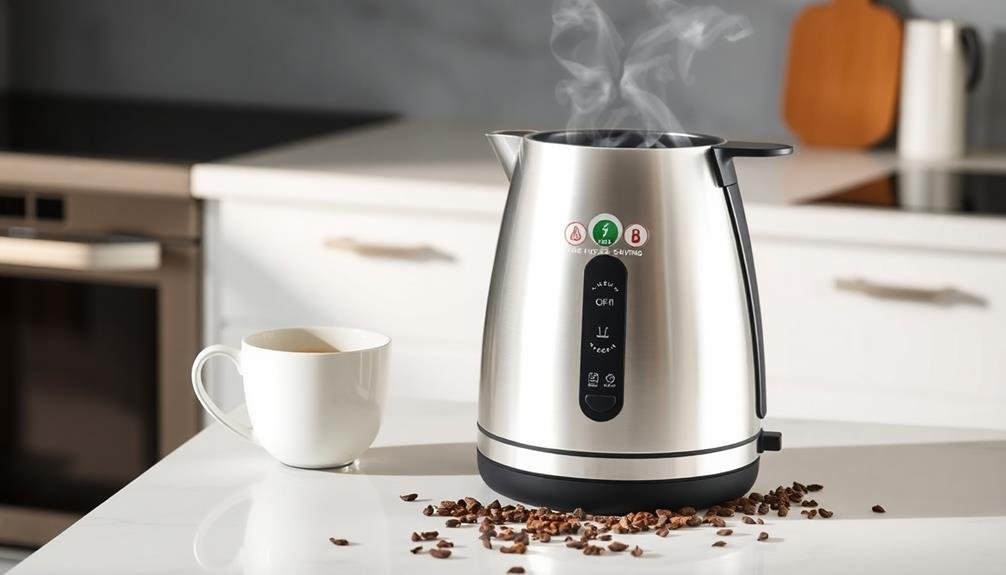
When choosing an eco-friendly kettle for your tea, you'll need to weigh the pros and cons of electric versus stovetop models.
Look for kettles with precise temperature control features to guarantee peak brewing while minimizing energy waste.
Check the energy efficiency ratings of electric kettles to find ones that use less power and help reduce your carbon footprint.
Electric vs. Stovetop Kettles
Many tea enthusiasts debate the merits of electric versus stovetop kettles when it comes to energy efficiency and eco-friendliness.
Electric kettles generally heat water faster and more efficiently than stovetop models, as they directly transfer heat to the water without losing energy to the surrounding air. This efficiency can lead to lower energy consumption and reduced carbon emissions.
However, stovetop kettles have their advantages. They're often more durable and can last for decades, reducing the need for replacements and associated waste. If you're using a gas stove, you're also directly heating the water without the energy loss that occurs in power plants and transmission lines for electricity.
Your choice between electric and stovetop kettles may depend on your energy source. If you have renewable electricity, an electric kettle might be the greener option. For gas stove users, a stovetop kettle could be more eco-friendly.
Regardless of your choice, you can maximize efficiency by only boiling the amount of water you need and maintaining your kettle properly to extend its lifespan.
Temperature Control Features
Leveraging advanced technology, energy-saving kettles and appliances with temperature control features offer a significant advantage for eco-conscious tea drinkers. These devices allow you to heat water to specific temperatures, ensuring ideal brewing conditions for different tea varieties while minimizing energy waste.
Many modern kettles come equipped with preset temperature buttons or adjustable controls, enabling you to select the perfect heat level for your chosen tea. Green teas, for instance, typically require lower temperatures around 160-180°F, while black teas steep best at 200-212°F. By heating water only to the necessary temperature, you'll conserve energy and enhance your tea's flavor profile.
Some kettles even feature keep-warm functions, maintaining your desired temperature for a set period. This can be particularly useful if you're brewing multiple cups throughout the day, as you won't need to reheat the water repeatedly.
Additionally, look for models with automatic shut-off mechanisms that power down the kettle once the water reaches the selected temperature, preventing unnecessary energy consumption.
When shopping for temperature-controlled kettles, consider those with insulated designs, as they'll retain heat more efficiently, further reducing your energy usage while ensuring your tea stays at the perfect temperature.
Energy Efficiency Ratings
Beyond temperature control features, energy efficiency ratings play a key role in selecting eco-friendly tea-steeping appliances. When shopping for kettles or electric tea makers, look for products with high energy efficiency ratings. These ratings, often displayed as stars or grades, indicate how well the appliance conserves energy during operation.
You'll want to prioritize kettles with rapid boil technology, which heat water quickly and use less energy overall. Many modern kettles also feature automatic shut-off mechanisms that prevent unnecessary energy consumption once the water reaches the desired temperature.
Some advanced models even have standby modes that maintain water temperature with minimal energy use. Consider investing in a variable temperature kettle that allows you to select the exact temperature for different tea types. This precision heating prevents energy waste from overheating water.
Additionally, look for kettles with good insulation to retain heat longer, reducing the need for frequent reheating. By choosing energy-efficient appliances, you'll not only reduce your carbon footprint but also save on electricity bills while enjoying your favorite teas.
Frequently Asked Questions
How Does the Caffeine Content in Tea Affect Water Consumption?
Caffeine in your tea can increase your thirst, leading you to drink more water. However, tea itself is mostly water, so you're hydrating as you sip. Balance your intake to stay hydrated without overdoing it.
Can I Use Filtered Tap Water for Eco-Friendly Tea Steeping?
Yes, you can use filtered tap water for eco-friendly tea steeping. It's a great choice as it reduces plastic waste from bottled water. You'll get a clean taste while being environmentally conscious. Just guarantee your filter's well-maintained.
Are There Eco-Friendly Alternatives to Electric Kettles for Heating Water?
You've got eco-friendly options for heating water! Try a stovetop kettle, solar kettle, or camp stove. You can also use a French press with hot tap water or invest in a thermal carafe to keep water warm.
What's the Environmental Impact of Different Tea Packaging Materials?
You'll find that tea packaging materials vary in environmental impact. Loose tea in metal tins is often most eco-friendly. Paper tea bags are compostable, while plastic-based ones aren't. Avoid individually wrapped tea bags for less waste.
How Do Different Tea Cultivation Methods Affect Water Conservation Efforts?
You'll find that organic tea farming often uses less water than conventional methods. Shade-grown tea promotes water retention in soil. Terracing and contour plowing help prevent erosion. Some farmers use drip irrigation to conserve water efficiently.
In Summary
You've now got a toolkit for eco-friendly tea steeping. By choosing water-efficient teas, using reusable infusers, and trying cold brew methods, you're making a difference. Don't forget to heat water to the right temperature and measure precisely. Repurpose those used leaves and invest in energy-saving kettles. With these small changes, you'll enjoy your favorite brew while conserving water. It's a win-win for tea lovers and the environment. Sip sustainably!


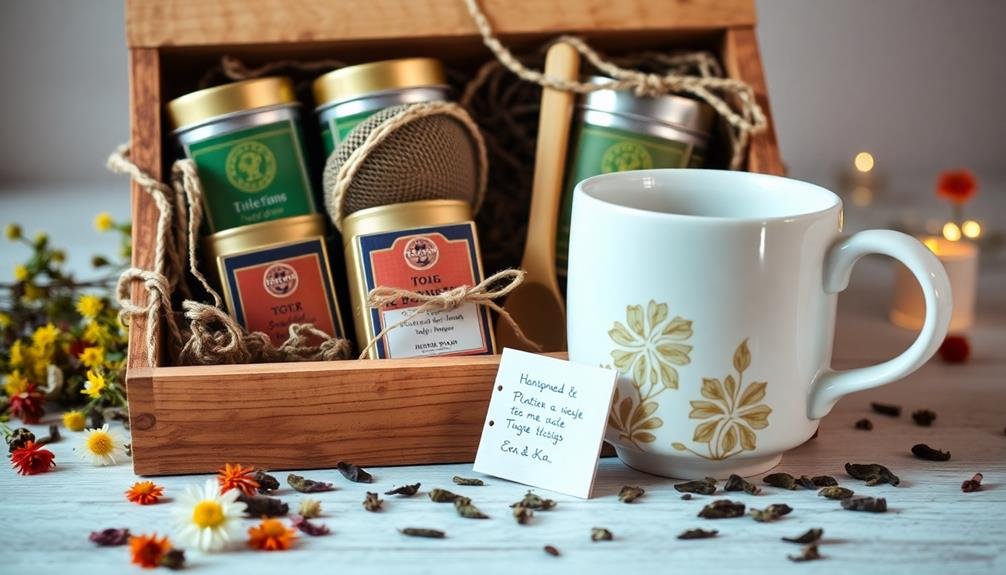
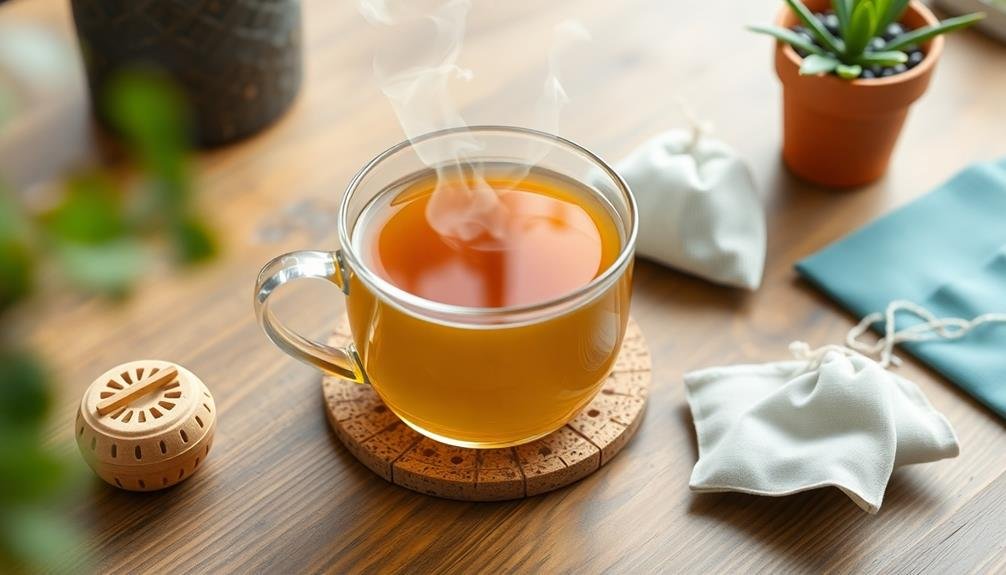
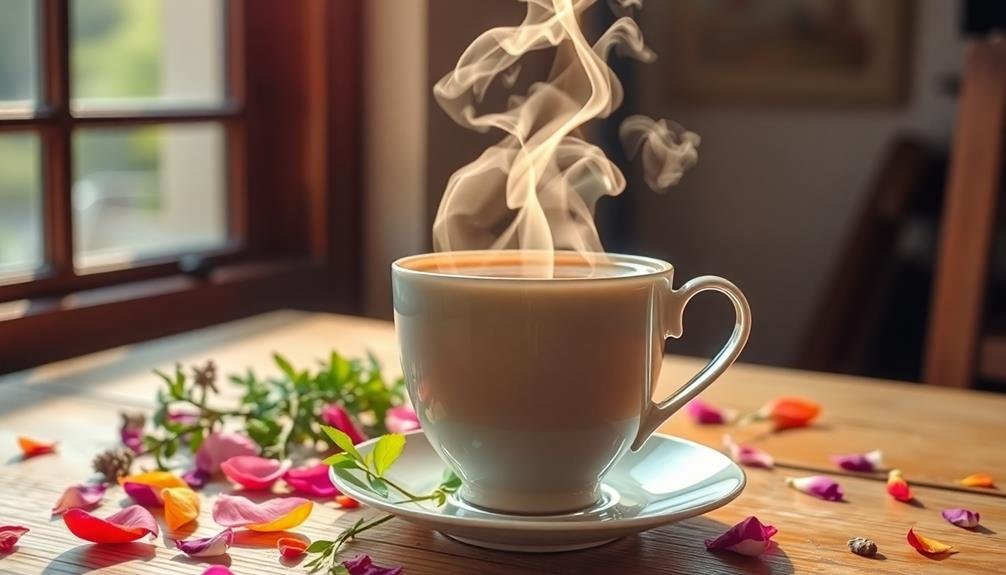
Leave a Reply